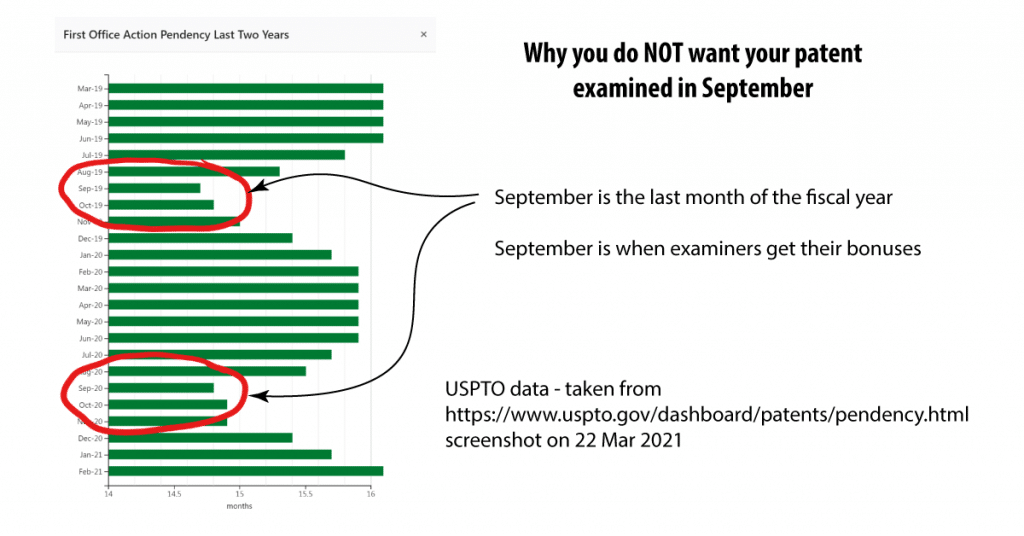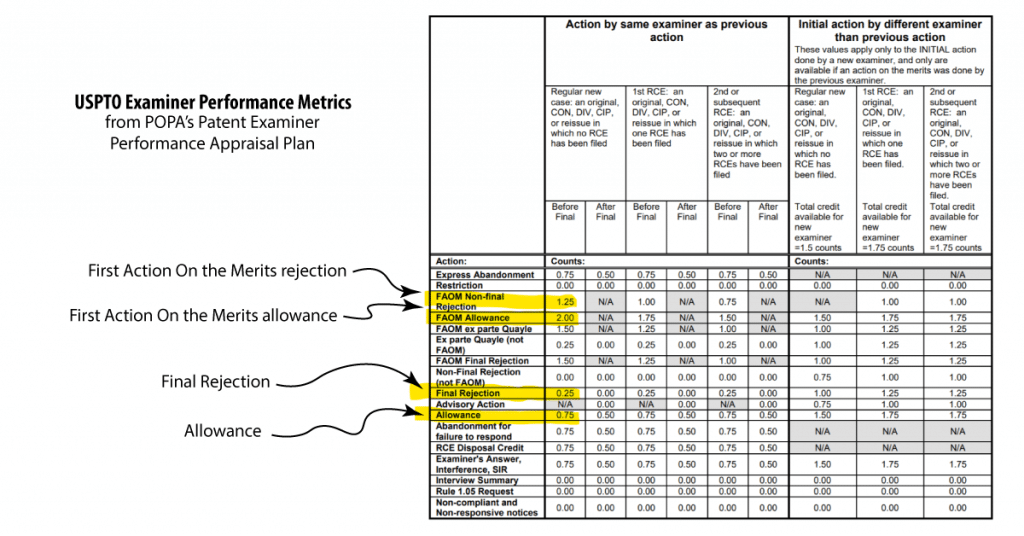Why patents in September are a bad thing
The USPTO issues more Office Actions in September than any other month. Why is that?

The chart above shows the USPTO pendency of First Actions over the last two years. Notice that there is a huge difference in September for the last two years.
What is this effect?
Patent Examiners have production goals and bonuses.
USPTO patent examiners are in a union, the Patent Office Professionals Association. Their work is defined by a Performance Appraisal Plan, which is agreed to between management and the union.
Production goals are 34% of an examiner’s evaluation. Examiners who exceed their production goals get bonuses, which is why you see production anomalies in September.
The key to an examiner’s performance is the number of “counts” they get for each type of activity during the patent prosecution. Some things – like interviews – are awarded no counts, but the big payoffs are the First Action On the Merits (FOAM in the table below) where there is an allowance. This is 2.00 counts. A first action rejection is only 1.25 counts, and a final rejection is 1.50 counts.
By the way, the “first action allowance” bonus is one of the disincentives of why Track One means a poorer examination and more questionable patents.
Here’s the table from the Performance Appraisal Plan that defines the “value” of each type of action an examiner does:

The more “counts” an examiner gets, the better their performance review, and the bigger their bonus.
Note that there is a huge incentive to allow a patent, especially in September when every count means a better review – and a bonus.
First Action on the Merits with an allowance is the highest prize. It is the biggest reward for the least amount of work, logistically speaking. Compare a first action allowance to a “normal” cadence of a non-final first action, then a second action that is final. In the second situation, the examiner has to handle the case twice and perform two searches (if the applicant amended the claims after the first Office action). For all that extra work, the examiner gets 1.50 counts if it is not allowed and 2.00 counts if it is allowed.
In an allowance on the First Action on the Merits, the examiner touches the case once, does one search, and gets the maximum reward.
Note that there is also an incentive to allow a case under final. A final rejection is worth 0.25 counts, while an allowance is worth 0.75 counts.
One of the reasons the top graph shows a big discrepancy during the month of September is that examiners notoriously grind out huge amounts of work in August/September to meet their production quotas.
As a practice tip, you never want to call an examiner in the last two weeks of a quarter – or any time in September. That is when they are nose-to-the-grindstone busy.
I look at hundreds of patents a month for different inventors. One inventor told me how his patent examiner was the nicest person and called them out of the blue. The examiner suggested some minor changes to the claims and was rushing them to agree. The inventor thought his patent was the greatest ever – but then I looked at the date of the Notice of Allowance. It was the last week of September.
As a patent owner, I try to avoid sending in any Office action responses in the months of July/August. This is simply that I don’t want my patents examined (either rejected or allowed) during the busy months of September. I try to hold off on responses until mid-September, so I know my patents will be examined during the slower, less hectic months of October/November.
My goal as a patent owner and financer is to get good examination. I don’t want a patent I don’t deserve, because I have a lot riding on them.